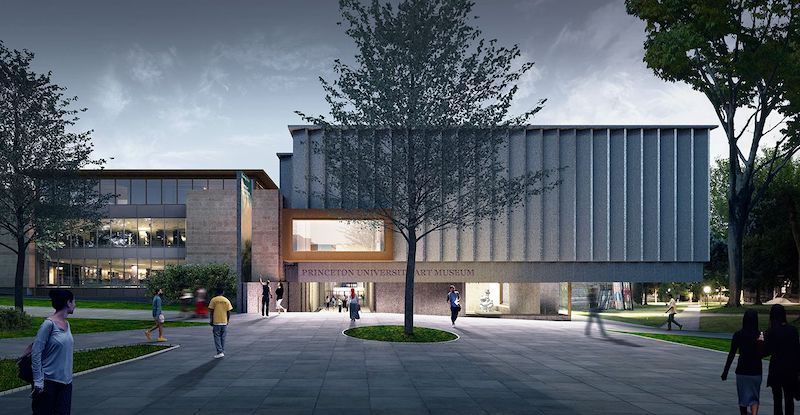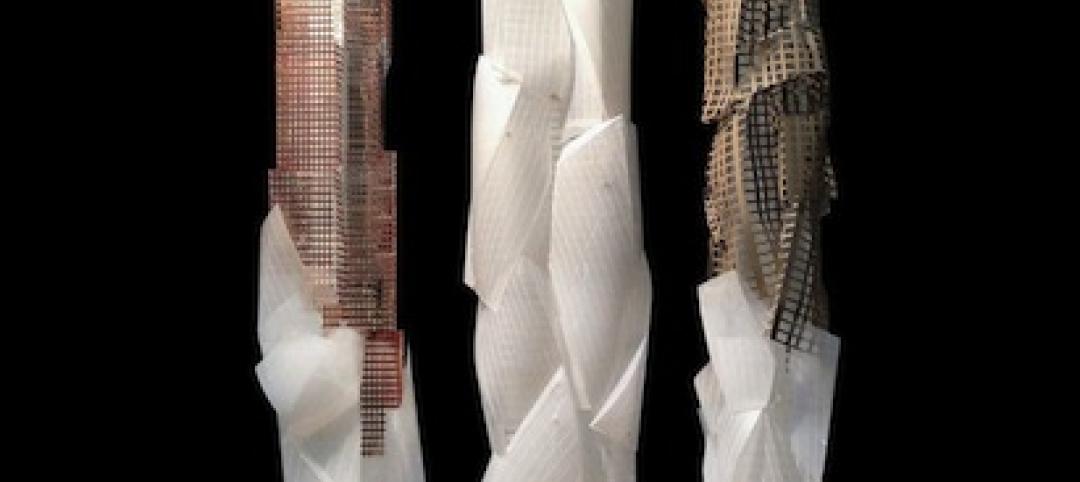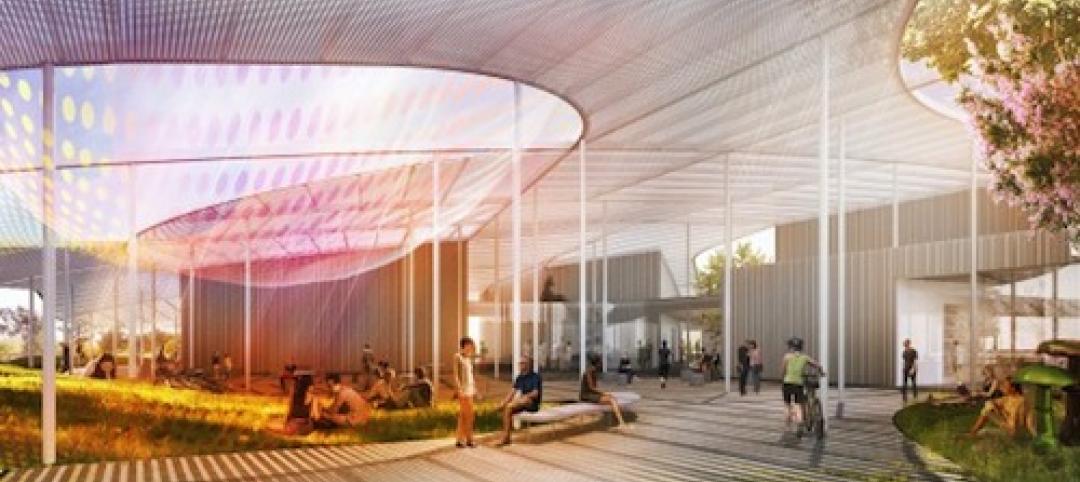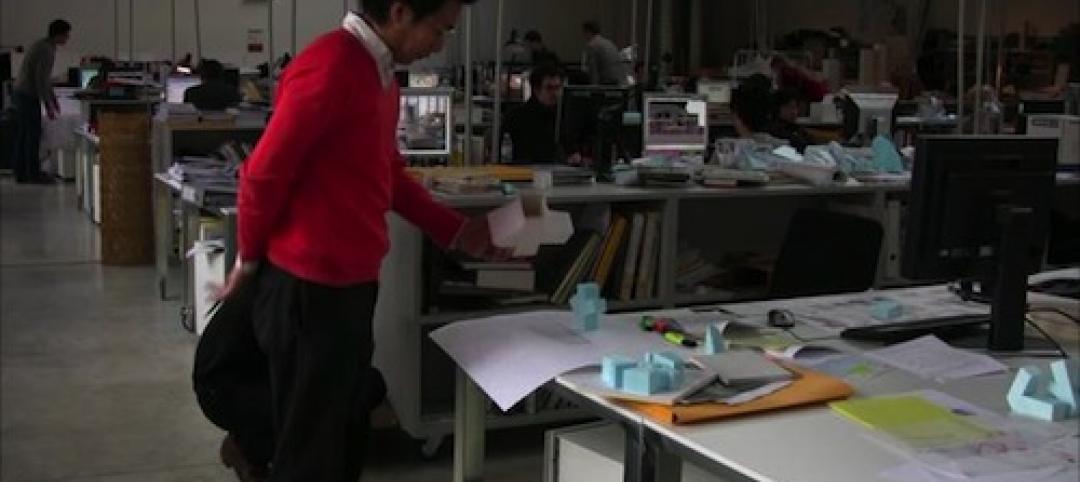One of the jewels in New Jersey’s cultural crown is Princeton University’s Art Museum, which was established in 1882, and whose present collection exceeds 110,000 objects. The museum is known for its Greek and Roman antiquities and Western European paintings. It also has a noteworthy collection of Asian art, as well as an extensive photography array.
But like most other institutions, Princeton’s museum only has enough space to exhibit a tiny fraction of its collection. Last month, the Art Museum unveiled the designs for a new 144,000-sf museum that would double the size of the existing building. James Steward, the museum’s director, estimates that the percentage of objects on view from permanent collections would triple to 6% in the new building, from 2% in the existing museum. And elements of visible storage will be featured throughout the new building.
Demolition of the existing museum—which is currently closed due to the coronavirus pandemic—is expected to begin in the middle of next year, with the goal of reopening in the new museum by late 2024.
CAMPUS ART MUSEUM DESIGN ALLOWS FOR GREATER ACCESS, CIRCULATION
Architect Sir David Adjaye’s three-story design breaks down the mass of the museum by creating nine interlocking cubes that relate to the scale of the university structures around it. (The current museum is located in the middle of the university’s wooded main campus.) Adjaye Associates collaborated on the museum’s design with executive architect Cooper Robertson.
There will be six ground-floor entrances in the new building (as opposed to one in the existing museum), making what Adjaye calls “a museum in the round.” The design also creates two enclosed “art walks” running north-south and east-west through the building’s ground floor.
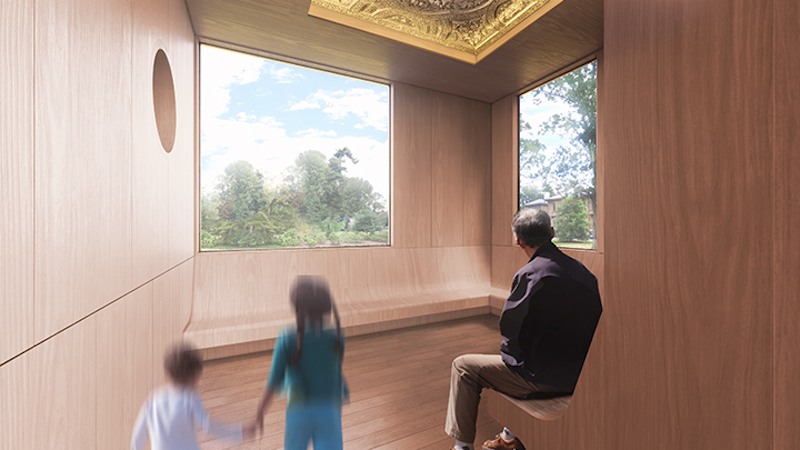
A singular “lens” moment at the complex’s northeast corner creates an intimate viewing and reading room, affords views onto the campus, and shapes a display opportunity for unique works from the collections. Image: Adjaye Associates
Each of the museum’s seven pavilions will include intimate spaces made from bronze and glass. All of the galleries will be on the second floor, a move that’s intended to smudge the lines that traditionally demarcate art by geography and historical period.
A CAMPUS WITHING A CAMPUS, THE ART MUSEUM WILL BE A DYNAMIC LEARNING CENTER
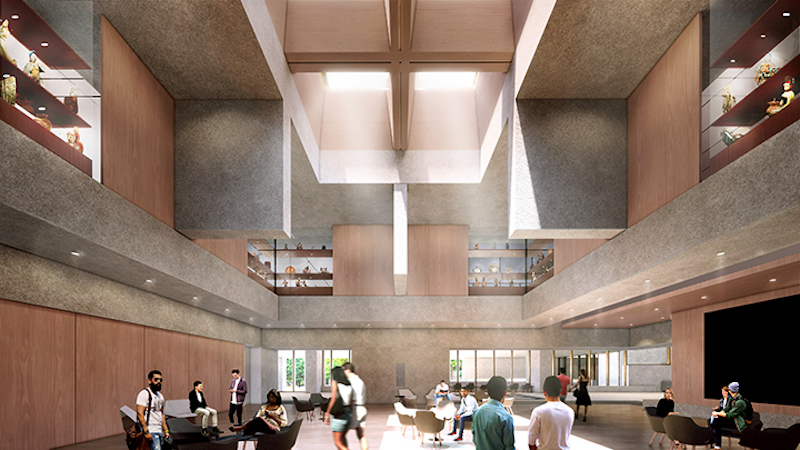
The double-height Grand Hall sits at the heart of the Museum complex and will function as a lecture hall and performance space that will host many of the Museum’s larger events. Image: Adjaye Associates
The design also includes outdoor terraces and spaces for performance and events that can accommodate anywhere from 200 to 2,000 people. These spaces include a hall for lectures, performances, and events; classrooms, two labs and a rooftop café. The design also shapes a new home for the University’s Department of Art & Archaeology, while retaining Marquand Library. Together, the three units would create a campus within a campus, and will continue to function as a dynamic center for research and teaching.
“I want the building to feel that it’s not just a hall of sacred objects but as … a common hall, so students can just go there if they feel like it and want to work close to those objects,” says Adjaye, whose firm was selected for this project in 2018. “If they have a compelling urge to see an incredible print or a sculpture or a delicate ceramic or bronze piece, it becomes a resource.”

The new museum will be built on the site of the older building, and be home to the university's Art & Archeology department. Image; Princeton University Art Museum
Steward, the museum’s director, told the Art Newspaper that 98% of the funds for the construction have been raised. He declined to disclose the construction cost.
Adjaye Associates has several prominent museum projects under its belt. It was one of several architect firms involved in the National Museum of African American History and Culture in Washington DC. The firm also designed the Studio Museum that’s under construction in Harlem in New York, the Museum of Contemporary Art in Denver, and the Ruby City art center in San Antonio.
Adjaye also served as a visiting professor at Princeton’s School of Architecture from 2008 to 2010.
Related Stories
| Jun 28, 2013
Building owners cite BIM/VDC as 'most exciting trend' in facilities management, says Mortenson report
A recent survey of more than 60 building owners and facility management professionals by Mortenson Construction shows that BIM/VDC is top of mind among owner professionals.
| Jun 25, 2013
Mirvish, Gehry revise plans for triad of Toronto towers
A trio of mixed-use towers planned for an urban redevelopment project in Toronto has been redesigned by planners David Mirvish and Frank Gehry. The plan was announced last October but has recently been substantially revised.
| Jun 25, 2013
DC commission approves Gehry's redesign for Eisenhower memorial
Frank Gehry's updated for a new Dwight D. Eisenhower memorial in Washington, D.C., has been approved by the Eisenhower Memorial Commission, reports the Washington Post. The commission voted unanimously to approve the $110 million project, which has been gestating for 14 years.
| Jun 5, 2013
USGBC: Free LEED certification for projects in new markets
In an effort to accelerate sustainable development around the world, the U.S. Green Building Council is offering free LEED certification to the first projects to certify in the 112 countries where LEED has yet to take root.
| Jun 3, 2013
Construction spending inches upward in April
The U.S. Census Bureau of the Department of Commerce announced today that construction spending during April 2013 was estimated at a seasonally adjusted annual rate of $860.8 billion, 0.4 percent above the revised March estimate of $857.7 billion.
| May 21, 2013
7 tile trends for 2013: Touch-sensitive glazes, metallic tones among top styles
Tile of Spain consultant and ceramic tile expert Ryan Fasan presented his "What's Trending in Tile" roundup at the Coverings 2013 show in Atlanta earlier this month. Here's an overview of Fasan's emerging tile trends for 2013.
| May 2, 2013
First look: UC-Davis art museum by SO-IL and Bohlin Cywinski Jackson
The University of California, Davis has selected emerging New York-based practice SO-IL to design a new campus’ art museum, which is envisioned to be a “regional center of experimentation, participation and learning.”
| Apr 30, 2013
Tips for designing with fire rated glass - AIA/CES course
Kate Steel of Steel Consulting Services offers tips and advice for choosing the correct code-compliant glazing product for every fire-rated application. This BD+C University class is worth 1.0 AIA LU/HSW.
| Apr 26, 2013
Documentary shows 'starchitects' competing for museum project
"The Competition," a new documentary produced by Angel Borrego Cuberto of Madrid, focuses on the efforts of five 'starchitects' to capture the design contract for the new National Museum of Art of Andorra: a small country in the Pyrenees between Spain and France.
| Apr 24, 2013
Los Angeles may add cool roofs to its building code
Los Angeles Mayor Antonio Villaraigosa wants cool roofs added to the city’s building code. He is also asking the Department of Water and Power (LADWP) to create incentives that make it financially attractive for homeowners to install cool roofs.


